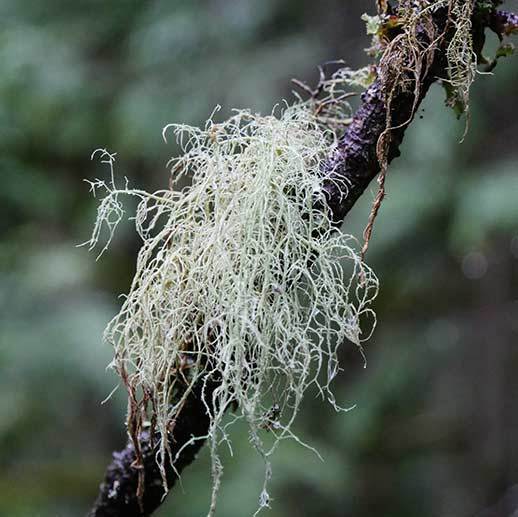The Beard of the Woods

Scientific name- Usnea common name: old man's beard
Many of us probably have not heard of a lichen- and if you have, you probably already know what it is. A lichen is an organism found on rocks or trees made of both a specific fungus and a specific alga that help one another. If you live in the PNW (or any conifer forest area, really) you have probably seen it everywhere. Usnea is a very abundant and versatile lichen and is easy for a beginner to identify. Many studies have proven its ability to fight of infections and bad bacteria, and that's just the tip of the iceberg!
Usnea is most well-known for its anti-microbial properties. Unlike prescribed antibiotics that kill ALL bacteria, good and bad, Usnea has been proven to leave the good gut bacteria alone and eradicate the bacteria causing us harm. While usnea is also widely known for its ability to attack gram positive bacteria such as staph infection or strep throat, a study in 2013 proved it was able to kill certain gram-negative bacteria. Gram negative bacteria typically has a thicker cell wall and adapts to medications much faster. A great aid for tuberculosis, pneumonia, strep throat, upper respiratory infections and UTI's. Externally, usnea can be made into a poultice as a band aid in nature or made into a powder to be directly applied to wounds.
As if being anti-microbial wasn't amazing enough, it works internally and externally to treat many fungal infections as well. Usnea is great for dandruff, ringworm, athlete's foot, jock itch and candida. For best results fighting off fungus OR bacteria, use usnea with other herbs such as black walnut hull, echinacea, chapparal and goldenseal. Also consider a sugar-free diet. While this lichen is busy cleaning out bacteria and infections, it's at work eradicating viral infections throughout the mucous membrane.
So, now that you know all of the good stuff about Usnea, let's talk about how to find it, and what to do when you DO find it. It's not called old man's beard for nothing; it resembles a beard growing off of branches of trees and shrubs. However as an avid forager, I like to remind people to familiarize themselves with the scientific names of things (usnea) so that they aren't confused with other plants that have the same slang name. While there are many different kinds of lichen, usnea is the only lichen that has a stretchy white core. If you pull a strand of the beard very gently, it will reveal a white core that will stretch before it snaps. Also known as the "lungs of the forest", it's extremely sensitive to pollutants and won't grow if the air quality is not good, and if you do happen to find it in a high traffic area, it's likely breathed in all of the pollutants and isn't viable to use medicinally. However, if you see it growing all around you on your hike in the mountains, take a deep breath because you know it's clean, fresh air! When foraging for usnea, I strongly suggest only collecting the fallen branches. While it may seem extremely abundant, and it is, lichen is EXTREMELY slow growing. Gathering the fallen branches should provide you with plenty, without disrupting the growth of the new lichen. Usnea should also be collected in the fall, preferably, as it's growing the most and putting out the most constituents.
Happy beard hunting!
